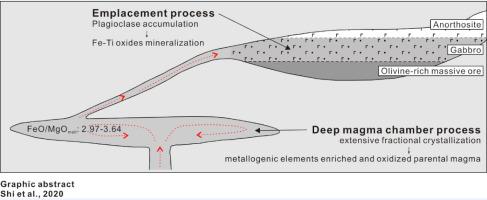Ore Geology Reviews ( IF 3.3 ) Pub Date : 2021-01-19 , DOI: 10.1016/j.oregeorev.2021.104003 Yu Shi , Yuwang Wang , Jingbin Wang , Guochao Zhou , Hongjing Xie , Dedong Li , Chunkit Lai , Hejun Tang

|
The Weiya is the largest magmatic Fe–Ti oxide deposit in the Chinese Eastern Tianshan orogen, and is divided into an eastern, central and western section by younger granitoid and diabase intrusions. The Weiya eastern section contain Fe-Ti oxide ores and ore-bearing apatite-poor layered gabbro, which display significant difference in mineral assemblage from the layered gabbro in the central section. We presented new data on the geology, mineralogy, petrology, geochemistry, geochronology, and Sr-Nd isotopes of the gabbroic rocks and the Fe-Ti oxide ores from the eastern section. Igneous zircons from the Weiya anorthosite yielded a SIMS U–Pb concordia age of 237.9 ± 0.71 Ma, coeval with the apatite-rich gabbro in the central section. The gabbroic rocks and Fe-Ti oxide ores in the eastern section and the central section have parallel chondrite-normalized REE patterns and N-MORB-normalized multi-element patterns, together with highly-similar Sr-Nd isotope features, suggesting that the two are comagmatic. Olivine Fo value (62.0–66.7), clinopyroxene Mg# number (68.1–76.2) and plagioclase An (54.9–58.7) contents suggest that the Weiya parental magma was highly evolved after extensive fractional crystallization in the deeper magma chamber, and the residual magma became increasingly oxidized and metals- and volatiles-rich. During the magma emplacement, plagioclase accumulated extensively in the magma chamber roof and further enriched Fe–Ti in the residual melts, leading to Fe–Ti oxide mineralization.



























 京公网安备 11010802027423号
京公网安备 11010802027423号